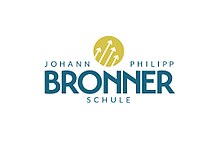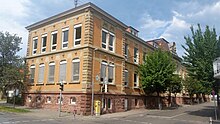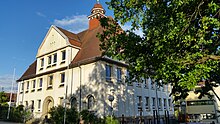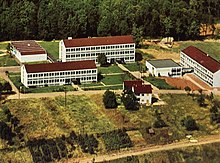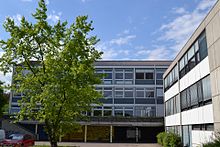Johann-Philipp-Bronner-School Wiesloch
| Johann Philipp Bronner School | |
|---|---|
| type of school | Commercial vocational school with WG , BK , BS and BFW |
| founding | 1907/1921 |
| address |
Gymnasiumstrasse 2 |
| place | Wiesloch |
| country | Baden-Württemberg |
| Country | Germany |
| Coordinates | 49 ° 17 ′ 45 " N , 8 ° 41 ′ 7" E |
| carrier | Rhein-Neckar district |
| student | 715 (2019/20) |
| Teachers | 50 |
| management | Susanne Zimmermann (since 2018) |
| Website | www.Bronner-Schule.de |
The Johann Philipp Bronner School is one of three vocational schools in Wiesloch, Baden-Württemberg . Under its umbrella are the commercial high school , the Commercial Vocational School I and II, the vocational school business (business school) and commercial vocational schools to find. The school was named after the wine pioneer Johann Philipp Bronner (1792-1864).
The Wiesloch vocational school center, which is located in the Wiesloch school center, includes the Bronner School for the commercial sector, the Hubert Sternberg School for the commercial / technical sector and the Luise Otto Peters School for the social / domestic sector.
School types
Commercial education
In the dual training program, around 250 trainees are trained in four different professions at the Bronner School. Lessons at the commercial vocational school (KBS) take place two days a week. The following professions are trained in the commercial area:
Full-time schools
Almost 500 students are currently taught full-time in different types of schools:
- The two-year Vocational School for Business (BFW) offers basic commercial training for students with a secondary school leaving certificate who achieve the technical college entrance qualification (Mittlere Reife) after two years .
- The Vocational College I and II (BK) builds on the technical college entrance qualification or middle school leaving certificate and enables further commercial education. With completion of the BK II, the students achieve the technical college entrance qualification for technical colleges in Baden-Württemberg.
- The Wirtschaftsgymnasium (WG) imparts the general higher education entrance qualification ( Abitur ) based on the technical college entrance qualification or middle school leaving certificate. It prepares students for studying at universities, colleges and vocational academies in three years. The focus is on the profile subject economics (with economics , business administration and accounting ).
history
In 1906, the Wiesloch municipal council resolved to set up a trade department for the vocational school, and the citizens' committee and the grand ducal state trade office approved this. The decision is preceded, among other things, by a submission from the businessman Ferdinand Mühl ("Manufacture, cloth and fashion goods, lingerie and furnishings, women's clothing and men's custom-made business") to found a business school.
In the following year, 1907, the trade department of the Wiesloch trade school begins with class I and 22 male students. In the following two years, the trading department is expanded to include grades II and III. Two commercial teachers give the lessons.
The Wiesloch commercial school was established as an independent school in 1921. In 1938 the district of Heidelberg took over the sponsorship of the vocational schools in Wiesloch. At the end of the war in 1945–46, classes at the commercial school are suspended.
A two-year business school was added to the existing commercial vocational school in 1955 (today: vocational school for business). There are now five full-time teachers teaching at the school. An application to establish a commercial college fails because of the proximity of Heidelberg.
The new and current school building on Gerbersruh was inaugurated in October 1959 as part of the vocational school center as part of the new Wiesloch school center.
In 1967 the two-year business school became the business school leading to the technical college entrance qualification. In the years of the “Schülerberg” four large parallel classes are run. The number of full-time teachers has grown to eight.
The business high school in its three-year form has enriched the educational offer of the commercial college since 1972. Three large parallel classes of grade 11 are added year after year. In 1972, 24 classes were taught by 31 full-time teachers.
In 1982 a specialist class for retail salespeople was established. At the same time, the secondary school authorities refused to set up a banking specialist class on the initiative of some banking institutes in Wiesloch. Here, too, the proximity to Heidelberg is a decisive argument against the facility.
At the suggestion of the school management and the school conference, the Wiesloch commercial college was also given the name "Johann Philipp Bronner School" in 1982 by resolution of the district council. At first it was the trade department of the vocational school, later called the "commercial training school". Since 1921 it traded with the "commercial school". From 1955 on, the sender could be found on letterheads as “commercial school and commercial vocational school” and around 1960 the name “commercial college” became established.
The Bronner School is expanded to include the Commercial Vocational College I in 1984. The 30 classes will be taught by around 40 full-time teachers in the coming school years. Of these, around 10 classes belong to the part-time area of the commercial vocational school.
In 1992, 800 former high school graduates met with their former teachers to celebrate the twentieth anniversary of the Wiesloch business school and the 200th birthday of Johann Philipp Bronners, whose name the school has been named for 10 years, with a festive event and an open day.
A former student (Schriever designer office, Nussloch) designed the school logo in 2000 according to the specifications of the general teachers' conference. In the same year, the business informatics profile was launched as a nationwide trial at the school.
The apprenticeships IT clerk and systems clerk have been trained at the Bronner School since 2001.
The Vocational College II - Economics and Data Processing has been taught at the school since 2004 and enables the acquisition of the technical college entrance qualification.
In 2004, training as a retail salesman was discontinued; instead, the school trained salespeople in wholesale and foreign trade. The last trainees in wholesale and foreign trade were accepted at the school in 2013, and the Bronner School has been training retailers again since 2014.
The Bronner School was awarded the nationwide title “School of the Year 2015” by the educational magazine Unicum .
In a six-month design thinking process , which the school carried out in cooperation with DHBW Mannheim , a new school logo and a new corporate design were developed for the Bronner School in 2017 , which will be introduced in 2018. From spring 2019, the school's public relations work will be professionalized together with three former students who have come together to form the start-up company "OnPras". In a first step, a four-minute image film was realized. In autumn 2019, over 700 students in 31 classes will be looked after by almost 50 teachers, and a practice company has been founded in the vocational college, which is connected to the learning factory for Industry 4.0 in the commercial neighboring school. The linking of a manufacturing execution system with an enterprise resource planning system in a school context is unique in Germany.
building
Gerbersruhschulhaus
The trade department of the Wiesloch trade school began teaching on April 15, 1907 in the right wing of the Gerbersruhschule.
Schiller Schoolhouse
The trade department moves into the newly built "Schillerschulhaus" in 1912, built as a trade, trade and agricultural school. In 1941 the district of Heidelberg bought the Schillerschulhaus from the city of Wiesloch as the new school authority.
In 1943 the Schillerschulhaus became the seat of the Mannheim military district command, and classes were initially held. In the last years of the war, 1945–46, classes at the commercial school ceased and the school inventory was placed in the agricultural school building on Schloßstraße. The Schillerschulhaus serves the German Red Cross as a reception center for displaced persons.
Classes are resumed in 1946 in the agricultural school (Gerbersruhschulhaus in Schloßstraße); for reasons of space, all classes take place in the afternoons. After several submissions from the school management, the Schillerschulhaus was reopened for the commercial, industrial, agricultural and home economics school in 1948, and the move took place in the same year. The number of pupils begins to increase, individual classes are accommodated in the Gerbersruhschule.
School center
In 1956, on the initiative of District Administrator Steinbrenner, the district of Heidelberg acquired 4.5 hectares of land in the “Obere Bohn” area, thus laying the foundation for today's vocational school center . The new school building of the commercial school (today building F1) is inaugurated in October 1959 with the auditorium (today building F5) after the plan to expand the Schiller school building had been rejected.
In 1973, only eight classrooms were available for 22 classes in the commercial college building, after which the first floor plan for an extension was submitted to the district council . This resulted in the extension buildings that were ceremoniously handed over on December 8, 1978 (WG / WS wing, today building F3), parallel to Gymnasiumstraße and the natural science wing with cafeteria (today building F2), parallel to Gerbersruhstraße up to the auditorium.
In 1983 the district sports hall for the vocational school center (today building S1) in the Wiesloch school center is inaugurated. In 1990, the press reported on the networking of the four IT rooms at the Bronner School and the refurbishment of the school with the most modern IT system in the Rhein-Neckar district.
In 1999, the Karlsruhe High School Office presented the Office for Schools, Culture and Sport in the Rhein-Neckar district with a space requirements plan, which introduced a second expansion of the school buildings that became necessary. This additional space requirement is due to the use of existing classrooms as specialist rooms in the IT area. In 2001, the expansion of the Wiesloch vocational school center begins; for the Bronner School this means an increase in the old building (building F1) and the renovation of its existing structure. The construction volume includes six new classrooms, four new project and meeting rooms, and the redesign of the teachers' room and the secretariat. In September 2004 the construction work was finished and the new rooms can be occupied.
The “Wiesloch Model” pilot project will be implemented in 2001. The vocational school center is being expanded by the school authority into a "networked school" with over 200 Internet access points. The Bronn school has six data processing rooms, a multimedia room as well as two networked PCs and a permanently installed projector in all class, subject, meeting and project rooms. Every student has their own access authorization and can work in the school network regardless of time and space. There is an average of 3.5 students per PC.
During the 2006 summer vacation, all classrooms in the WG / WS wing (building F3) will be renovated. The opening of a new cafeteria (building P1) at the auditorium will be celebrated in 2008. This enables all-day school operation for the upper level of the WG. The renovation of the science wing (building F2) will take place in the summer vacation 2013, at the same time the old cafeteria from 1978 will be converted into a school's own fitness studio , which is open to students on all school days.
Due to the refugee crisis in Germany from 2015 onwards , the district sports hall in the vocational school center (building S1) will become a needs-based initial reception facility in the Rhein-Neckar district for male refugees traveling alone for the entire 2015/2016 school year . The interior of the district sports hall will be renovated in summer 2016, so that it will be available again for school and club sports from October.
As a result of restructuring, the previous class work room will be built into a new student lounge and a classroom in the form of a contemporary open- plan office for the new training company "Bronner Bikes" .
School boards and principals
- 1907–1911: School board : Heinrich Mack
- 1911–1917: School board: Albrecht Maurus
- 1917–1921: School board: Edgar Wolbert
- 1921–1945: Headmaster : Richard Fleck
- 1946–1961: Headmaster: Wilhelm Rausch
- 1961–1980: Headmaster: Hans Müller-Romeis
- 1980–1999: Headmaster: Gustav Henry
- 1999–2018: Headmaster: Reinhard Müller
- since 2018: Headmistress: Susanne Zimmermann
Catchment area
Around 700 students from four federal states attend the Bronner School.
| origin | places | Students at the school |
|---|---|---|
| Wiesloch | Large district town of Wiesloch | 23% |
| Remaining parishes | Dielheim , Leimen , Malsch , Mühlhausen , Nussloch , Rauenberg , Sandhausen , St. Leon-Rot and Walldorf | 58% |
| Remaining Rhein-Neckar-Kreis with Heidelberg and Mannheim | Rhein-Neckar-Kreis without Wiesloch and Sprengelgemeinden with Heidelberg and Mannheim | 10% |
| District of Karlsruhe with Karlsruhe | District of Karlsruhe and Karlsruhe | 6% |
| Rest of Baden-Württemberg | Neckar-Odenwald , the district of Heilbronn , Göppingen district and Ortenaukreis | 1 % |
| Neighboring federal states | Bavaria , Hesse and Rhineland-Palatinate | 2% |
Partnerships and collaborations
Partnerships with other schools
- Since the 1980s, the Bronner School has had a partnership with the "Lycée Professional Privé - St. Francois d'Assise" in Fontenay-aux-Roses in France , region Île-de-France , 575 km away .
- Since 2013 the Bronner School has had a partnership with the "IES Poeta Julián Andúgar", in Santomera in Spain , 1,870 km away , Murcia region .
- In 2018 an annual exchange program was set up with the Gordons Schools in Huntly (Scotland) , Aberdeenshire region , in north-east Scotland .
- In addition, since 2018 there has been an exchange cooperation with the "State Pedagogical University of the Urals" in Yekaterinburg , in Sverdlovsk Oblast , in the Urals of Russia .
This means that students in all four foreign languages taught at the Bronner School have the opportunity to take part in an exchange program.
Cooperation between learning locations
The Bronnerschule also maintains close contact with businesses and companies in the area, especially with those whose trainees attend the school. In recent years this has resulted in cooperation between learning locations, which enables even closer collaboration and an exchange of information and services for the benefit of the students. At the moment there are such partnerships with Sparkasse Heidelberg , Heidelberger Druckmaschinen AG and SAP SE .
In addition, the Bronner School is a cooperation school of the Heidelberg Theater and Orchestra and the Philharmonic Orchestra , which is why all full-time students attend a theater performance with their class once per school year.
Known students
- Ingo Morano, Prof. Dr. for physiology , cell biology and cardiovascular research at the Max Delbrück Center for Molecular Medicine in the Helmholtz Association of the Federal Government in Berlin and the Cardiovascular Research Center (CCR) of the Charité Berlin
- Ute Vogt , SPD politician (former Parliamentary State Secretary to the Federal Minister of the Interior and former state chairwoman of the SPD in Baden-Württemberg )
- Kevin Knödler, soccer goalkeeper (formerly with TSG 1899 Hoffenheim and SV Waldhof Mannheim )
- Jonas Strifler , soccer player (formerly with TSG 1899 Hoffenheim and SV Sandhausen )
- Marius Steinhauser , handball player (formerly with Rhein-Neckar Löwen and SG Flensburg-Handewitt )
- Marco Bitz, handball player at Rhein-Neckar Löwen
- Frank Müller, handball player (formerly with Rhein-Neckar Löwen , TSG Friesenheim and SG Nussloch )
- Lukas Rolko, water polo player (formerly White Sharks Hannover, German national team, currently at SGW Leimen-Mannheim)
Schools in the Wiesloch school center
- Johann Philipp Bronner School (commercial vocational school)
- Hubert-Sternberg-Schule (commercial-technical vocational school)
- Louise Otto Peters School (domestic and social vocational school)
- Ottheinrich-Gymnasium Wiesloch (general high school)
- Bertha Benz Realschule (Realschule)
- Albert Schweitzer School (special school, focus: learning)
- Tom-Mutters-Schule (special school, focus: mental development, physical and motor development)

